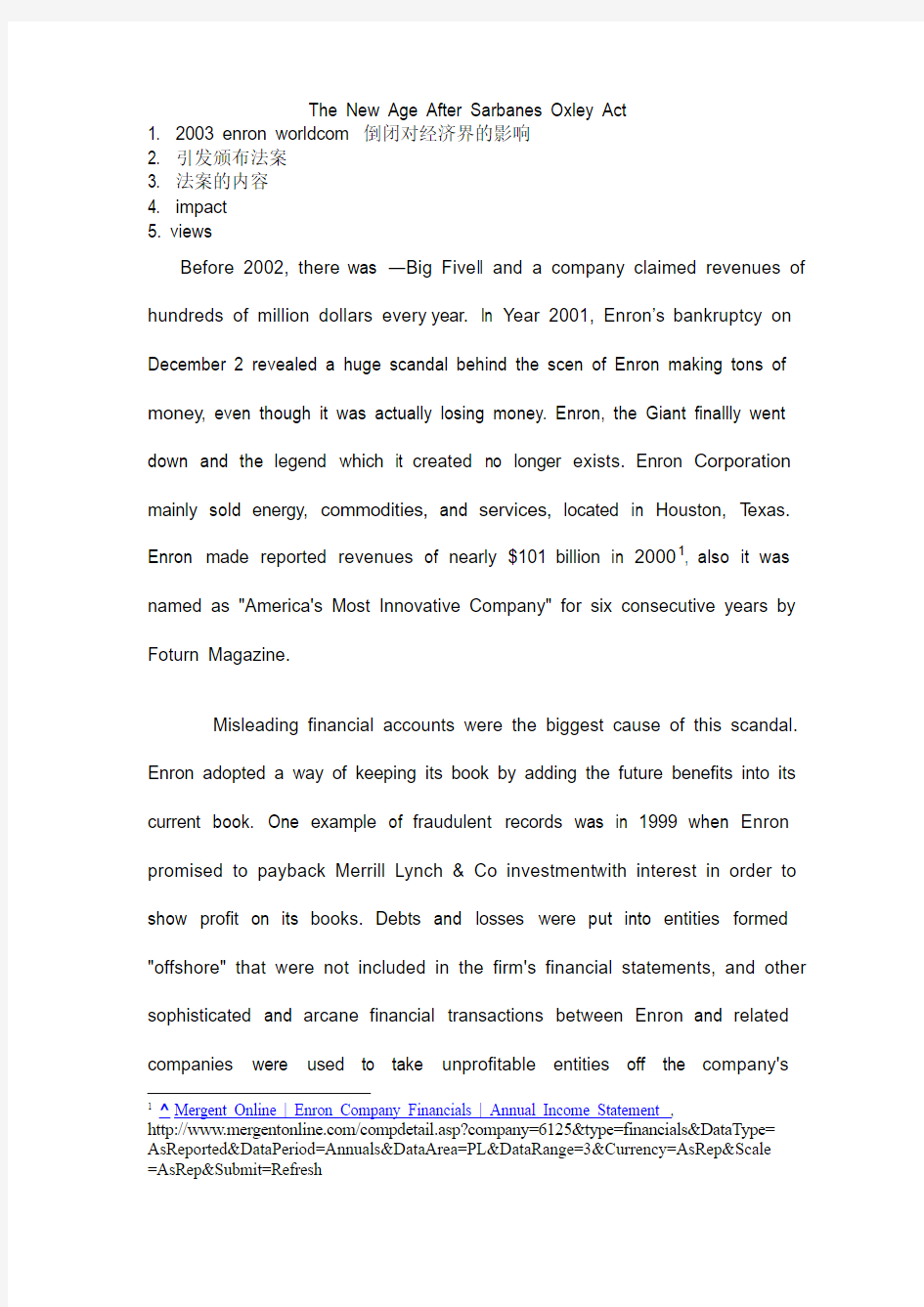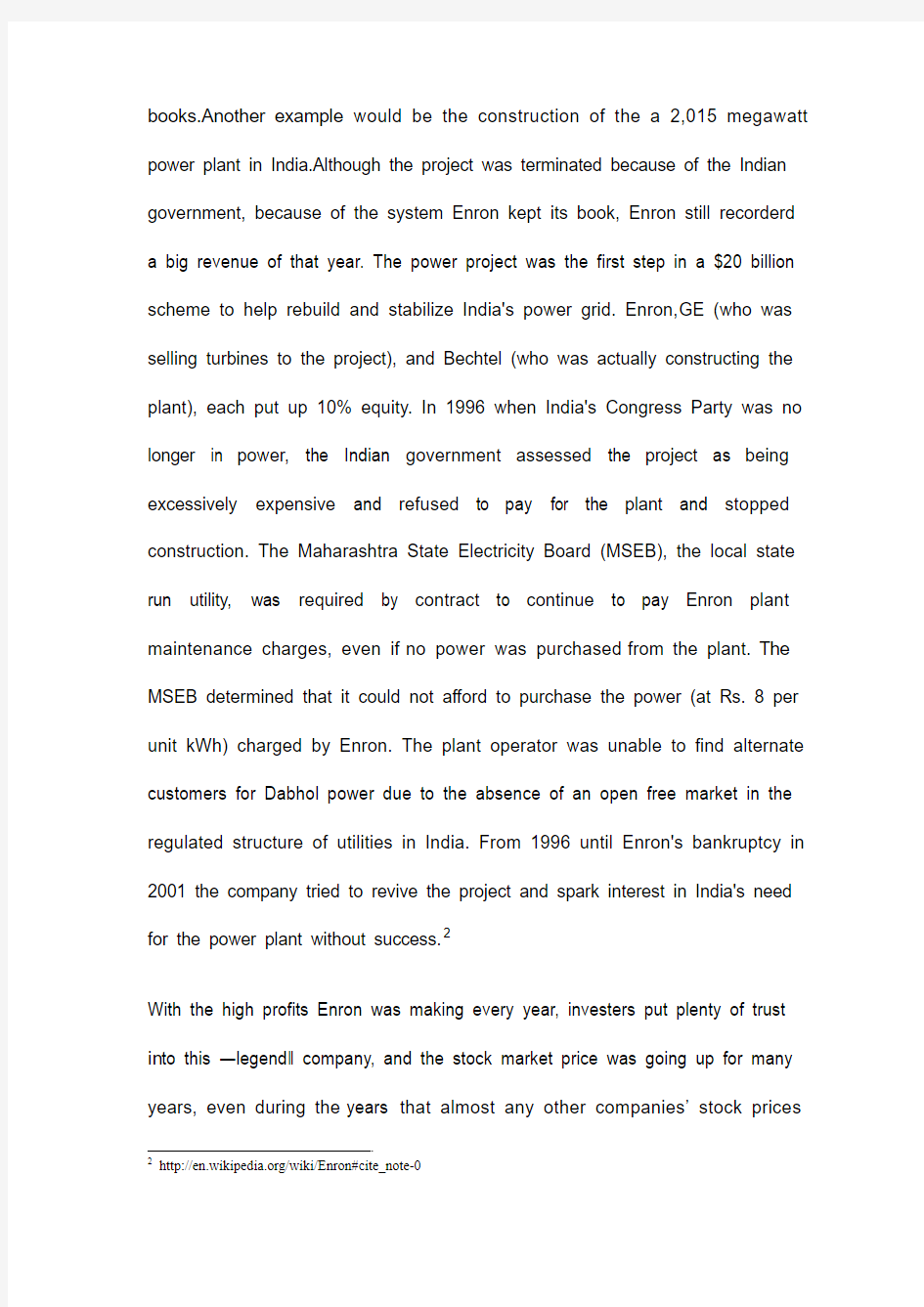

The New Age After Sarbanes Oxley Act
1. 2003 enron worldcom 倒闭对经济界的影响
2. 引发颁布法案
3. 法案的内容
4. impact
5. views
Before 2002, there was ―Big Five‖ and a company claimed revenues of hundreds of million dollars every year. In Year 2001, Enron’s bankruptcy on December 2 revealed a huge scandal behind the scen of Enron making tons of money, even though it was actually losing money. Enron, the Giant finallly went down and the legend which it created no longer exists. Enron Corporation mainly sold energy, commodities, and services, located in Houston, T exas. Enron made reported revenues of nearly $101 billion in 20001, also it was named as "America's Most Innovative Company" for six consecutive years by Foturn Magazine.
Misleading financial accounts were the biggest cause of this scandal. Enron adopted a way of keeping its book by adding the future benefits into its current book. One example of fraudulent records was in 1999 when Enron promised to payback Merrill Lynch & Co investment with interest in order to show profit on its books. Debts and losses were put into entities formed "offshore" that were not included in the firm's financial statements, and other sophisticated and arcane financial transactions between Enron and related companies were used to take unprofitable entities off the company's 1^Mergent Online | Enron Company Financials | Annual Income Statement,
https://www.doczj.com/doc/1218166694.html,/compdetail.asp?company=6125&type=financials&DataType= AsReported&DataPeriod=Annuals&DataArea=PL&DataRange=3&Currency=AsRep&Scale =AsRep&Submit=Refresh
books.Another example would be the construction of the a 2,015 megawatt power plant in India.Although the project was terminated because of the Indian government, because of the system Enron kept its book, Enron still recorderd a big revenue of that year. The power project was the first step in a $20 billion scheme to help rebuild and stabilize India's power grid. Enron, GE (who was selling turbines to the project), and Bechtel (who was actually constructing the plant), each put up 10% equity. In 1996 when India's Congress Party was no longer in power, the Indian government assessed the project as being excessively expensive and refused to pay for the plant and stopped construction. The Maharashtra State Electricity Board (MSEB), the local state run utility, was required by contract to continue to pay Enron plant maintenance charges, even if no power was purchased from the plant. The MSEB determined that it could not afford to purchase the power (at Rs. 8 per unit kWh) charged by Enron. The plant operator was unable to find alternate customers for Dabhol power due to the absence of an open free market in the regulated structure of utilities in India. From 1996 until Enron's bankruptcy in 2001 the company tried to revive the project and spark interest in India's need for the power plant without success.2
With the high profits Enron was making every year, investers put plenty of trust in to this ―legend‖ company, and the stock market price was going up for many years, even during the years that almost any other companies’ stock prices
were going down. As the scandal unrevealed, Enron shares dropped from over US$90.00 in the summer of 2000 to just pennies. Enron had been considered a blue chip stock, so this was an unprecedented and disastrous event in the financial world. Enron's plunge occurred after it was revealed that much of its profits and revenue were the result of deals with special purpose entities (limited partnerships which it controlled). The result was that many of Enron's debts and the losses that it suffered were not reported in its financial statements.
As the Chief Executive Officer, Lay has been accused of selling over $70 million worth of stock at this time, which he used to repay cash advances on lines of credit. He sold another $20 million worth of stock in the open market. Also, Lay's wife, Linda, has been accused of selling 500,000 shares of Enron stock totaling $1.2 million on November 28, 2001.
Enron was striken down when it was found out that Arthur Anderson did not fulfill its professional responsibilities in connection with its audits of Enron’s financial statements, or its obligation to bring to the attention of Enron’s Board. On June 15, 2002, Andersen was convicted of obstruction of justice for shredding documents related to its audit of Enron, resulting in the Enron scandal. Since the U.S. Securities and Exchange Commission does not allow convicted felons to audit public companies, the firm agreed to surrender its CPA licenses and its right to practice before the SEC on August 31, 2002 -
effectively putting the firm out of business. It had already started winding down its American operations after the indictment, and many of its accountants joined other firms. The firm sold most of its American operations to KPMG, Deloitte & Touche, Ernst & Young and Grant Thornton LLP, and the Big Five turned to Big Four. The damage to Andersen's reputation also destroyed the viability of the firm's international practices. Most of them were taken over by the local firms of the other major international accounting firms. The subsequent bankruptcy of WorldCom, which quickly surpassed Enron as the then biggest bankruptcy in history (the record is now held by Lehman Brothers and Washington Mutual) led to a domino effect of accounting and like corporate scandals that continue to tarnish American business practices.
On May 31, 2005, in the case Arthur Andersen LLP v. United States, the Supreme Court of the United States unanimously reversed Andersen's conviction due to what it saw as serious flaws in the jury instructions.3In the court's view, the instructions were far too vague to allow a jury to find obstruction of justice had really occurred. The court found that the instructions were worded in such a way that Andersen could have been convicted without any proof that the firm knew it had broken the law or that there had been a link to any official proceeding that prohibited the destruction of documents. The opinion, written by Chief Justice William Rehnquist, was also highly skeptical of the government's concept of "corrupt persuasion"—persuading someone to 3Arthur Andersen LLP v. United States, 544 U.S. 696,
engage in an act with an improper purpose even without knowing an act is unlawful.
T he bankrupcy of Enron broke many people’s trusts towards investments, and for a while the investment market was at its lowest point. People do not trust the financial statesment as much as before and companies with truly values even could not find investors. U.S. Senator Paul Sarbanes (D-MD) and U.S. Representative Michael G. Oxley came up with the Sarbanes- Oxley Act which evetually turns into United States Federal Law that set new rules over the regulation of all U.S. public company boards, management and public accounting firms.
The act contains 11 titles, or sections, ranging from additional corporate board responsibilities to criminal penalties, and requires the Securities and Exchange Commission (SEC) to implement rulings on requirements to comply with the law. Harvey Pitt, the 26th chairman of the SEC, led the SEC in the adoption of dozens of rules to implement the Sarbanes–Oxley Act. It created a new, quasi-public agency, the Public Company Accounting Oversight Board, or PCAOB, charged with overseeing, regulating, inspecting and disciplining accounting firms in their roles as auditors of public companies. The act also covers issues such as auditor
independence, corporate governance, internal control assessment, and enhanced financial disclosure.4
The goals of the Sarbanes-Oxley Act are far-reaching, and aim to restore investor confidence in and assure the integrity of our markets. Consequently, the reforms in the Act address nearly every aspect and actor in our nation’s capital markets. The Act affects every reporting company, both domestic and foreign, as well as their officers and directors and other key participants in our capital markets. The principal objectives addressed in the Act can be grouped into the following themes:
To strengthen enforcement of the federal securities laws;
To strengthen and restore confidence in the auditing profession;
To improve executive responsibility and the ―tone at the top‖ at
companies;
To improve disclosure and financial reporting; and
To improve the performance of gatekeepers, such as accounting firms, research analysts and attorneys.5
Another critical objective of the Act was to improve executive responsibility and the ―tone at the top‖ of public companies. The Act affirms senior executive responsibility for the financial reporting process of public companies by requiring CEOs and CFOs to certify the financial and other
4 https://www.doczj.com/doc/1218166694.html,/wiki/Sarbanes%E2%80%93Oxley_Act
5 Testimony C oncerning the Impact of the Sarbanes-Oxley Act, https://www.doczj.com/doc/1218166694.html,/news/testimony/ts042105whd.htm
information in their reports filed with the Commission.6
In addition to increasing focus on executive responsibility, the Act takes several important steps toward improving disclosure and the financial reporting process. Accurate and reliable financial reporting is the bedrock of our disclosure-based system of securities regulation.
Overall, the Sarbeanes-Oxley Act further regulates the investing market with the law reinforcement, and by practicing it, the market eventually recovered from the stock market attack causing by the fraud activities going on in the big companies.
6Testimony Concerning the Impact of the Sarbanes-Oxley Act, https://www.doczj.com/doc/1218166694.html,/news/testimony/ts042105whd.htm